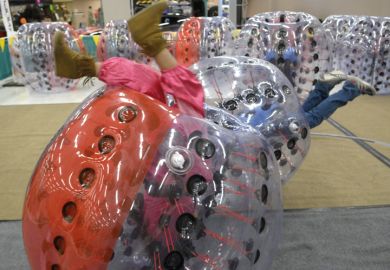Active learning approaches significantly narrow the academic performance gap between students from demographic groups that are over-represented and under-represented in science, technology, engineering and mathematics, according to a new study.
A paper from researchers at the University of Washington combines student-level data from dozens of individual studies to investigate how student performance changed when instructors switched from passive techniques, such as traditional lectures, to discussion-based and problem-solving methods in undergraduate STEM courses.
It found that the achievement gap between over-represented and under-represented students narrowed by 33 per cent on exam scores and by 45 per cent on course pass rates.
For “high-intensity” active learning courses, in which students spent at least two-thirds of total class time engaged in active learning, the gaps shrank by 42 per cent and 76 per cent respectively for exam scores and pass rates, suggesting that the flipped classroom model could be a way to reduce inequity in higher education.
Under-represented students included low-income, Latinx, African American, Native American and Native Hawaiian and Pacific Islander students. The exam score data came from 15 studies, representing more than 9,000 students, while the data on pass rates came from 26 studies of more than 44,000 students.
Elli Theobald, a research associate and instructor in Washington’s biology department and lead author of the research, which was published in the Proceedings of the National Academy of Sciences, said that active learning techniques may create a more welcoming and inclusive environment, which could be especially important for under-represented students who may “feel excluded” or as if they don’t belong in STEM.
Active learning may also help students comprehend material better by taking them through complex concepts, step by step, she said.
Previous research from the National Academy of Sciences, cited in the study, found that six years after starting a STEM degree, 20 to 30 per cent of Latinx, African American and Native American students have finished it, compared with 43 per cent of white students and 52 per cent of Asian Americans.
Eric Mazur, Balkanski professor of physics and applied physics at Harvard University, and the father of the flipped classroom model, said that the results of the paper were “very interesting” and “further show the benefits of active learning”.
“Anything that can be done to reduce inequity must be taken very seriously,” he said.
POSTSCRIPT:
Print headline: Active learning ‘shrinks STEM attainment gap’
Register to continue
Why register?
- Registration is free and only takes a moment
- Once registered, you can read 3 articles a month
- Sign up for our newsletter
Subscribe
Or subscribe for unlimited access to:
- Unlimited access to news, views, insights & reviews
- Digital editions
- Digital access to THE’s university and college rankings analysis
Already registered or a current subscriber? Login








